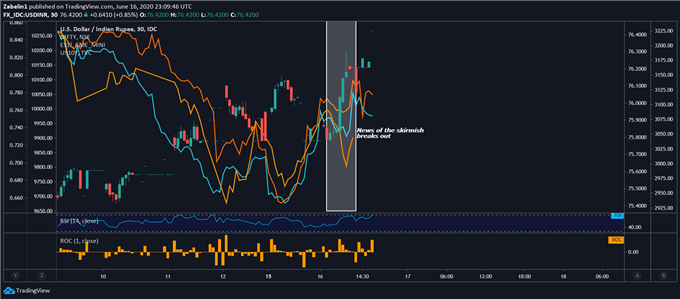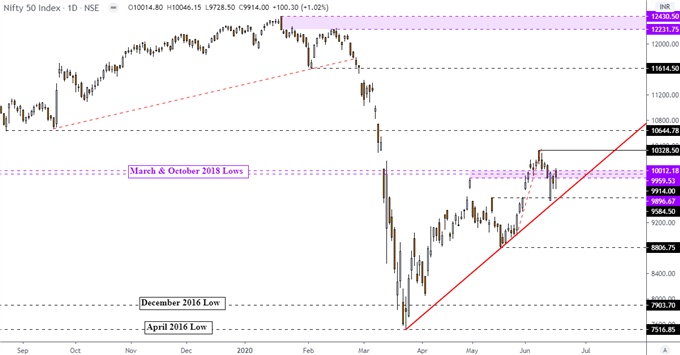Indian Rupee, USD/INR, China-India Border Dispute, Nifty 50 – TALKING POINTS
- Indian Rupee, Nifty 50 vulnerable to escalating China-India tensions
- Coronavirus cases spike in China, India wrestles with deep recession
- USD/INR may rise after resistance break, will Nifty 50 clear support?
The US Dollar rose versus the Indian Rupee after news broke of a skirmish between Indian and Chinese soldiers along a disputed border – known as the Line of Actual Control (LAC) – in the Himalayan Mountains. The subsequent risk aversion pressured US equity futures and India’s benchmark Nifty 50 stock index while Treasury yields briefly spiked along with the anti-risk Japanese Yen.



USD/INR Surged With Treasury Yields as SPX Futures, Nifty Index Dipped – 15-Minute Chart

USD/INR chart created using TradingView
Preliminary reports indicate approximately 20 Indian soldiers were killed after – according to officials in New Delhi – Chinese soldiers provoked an attack. Beijing retorted that it was the Indian troops who had initiated the hostilities. The last time both nuclear powerhouses saw this degree of conflict was back in the 1970’s, but this incident comes as a result of increased tensions over the past few months.
Both China and India have been increasing efforts towards to expand infrastructure projects and military installations in the disputed region as a way to limit the other’s territorial ambitions. The result has been an notable increase of tensions and higher rates of non-lethal engagements between soldiers ranging from shouting matches to full-on brawls.
Dean of the Jindal School of International Affairs Sreeram Chaulia says China’s bolder action at this time may be a strategic exploitation of India’s current circumstances. As the latter attempts to deal with the health and economic crisis of Covid-19, the allocation of resources to those issues could hinder a prompt and strong response to concerns in the Himalayan Mountains.
It would also give Beijing “a chance to edge its forces deeper into the disputed territory in hopes of obstructing New Delhi’s border infrastructure development” (WSJ). Having said that, in the months leading up to this conflict, China and India have mobilized thousands of additional troops and military hardware to strategic, high-altitude points.



Line of Actual Control

Source: New York Times
The geographical specification is important: during the summer months, higher temperatures cause the snow to melt, thereby making patrolling and infrastructure development comparatively easier. Other officials state that India’s strong response to China comes amid fear of the Asian giant’s political ambitions given its actions in Hong Kong, the South China Sea and continual tension with Taiwan.
If tensions between China and India continue to grow, the cross-asset impact may be considerably larger now than before given the vulnerability of the global economy amid the coronavirus pandemic. Beijing is reporting another spike of infections while India – the fourth most-infected country in the world behind Russia – wrestles with what could be its worst recession since the 1970’s.
Indian Rupee Technical Analysis
This is as the Indian Rupee could be at risk of further losses against the US Dollar. On the daily chart below, USD/INR is attempting to push above key resistance which is a range between 75.97 – 76.24. This follows a push above near term falling resistance from April’s top – blue line. Upside follow-through is lacking at this point, but another close above resistance could pave the way for a test of 77.
Beyond current 2020 peak, which is also the record high, sits the 38.2% Fibonacci extensions at 77.49. Pushing above this price exposes the midpoint of the extension at 78.28. Should USD/INR descend on the other hand, prices may bounce off support (74.95 – 75.27). If enough sellers overpower buyers, further losses from there may place the focus on key rising support from July 2019 – red lines.
USD/INR – Daily Chart

USD/INR Chart Created in TradingView
Nifty 50 Technical Analysis
Despite recent losses, the Nifty 50 remains in its key uptrend since prices bottomed in late March. This is defined by rising support – red line on the daily chart below. Prices recently bounced off this slope of appreciation, pressuring the 9959 – 10012 inflection point. Further gains from here could see the Nifty 50 test resistance at 10328.
If prices push above the latter, that would expose the August 2019 low at 10644 which could stand in the way as new resistance. A push above this price could pave the way for a test of 11614 which is the January low. India’s benchmark stock index may set course for a reversal if the rising trend line falls apart. A potentially key level of support to watch for follow-through seems at 9584. Further losses exposes the May trough at 8806.
Nifty 50 – Daily Chart

Nifty 50 Chart Created in TradingView
--- Written by Dimitri Zabelin and Daniel Dubrovsky, Currency Analysts for DailyFX.com
To contact Dimitri and Daniel, use the comments section below or @ZabelinDimitri and @ddubrovskyFX Twitter






